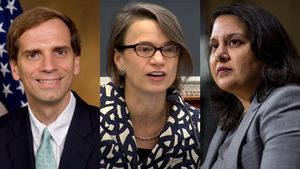The 2015 Paris Climate Accords set a limit on emissions allowed from the 194 nations that ratified it. Today, the world is "nowhere near" that target.
By the end of the century, the United Nations estimated that temperatures will rise to 4.5 degrees Fahrenheit above the pre-industrial average, a full degree higher than the goal set by the Paris Agreement.
From 2010 to 2030, experts expected emissions to increase by 10.6 percent. While that number has decreased from last year, head of the U.N. climate office Simon Stiell said in a statement that global efforts are still falling short.
“We are still nowhere near the scale and pace of emission reductions required to put us on track toward a 1.5 degrees Celsius world," he wrote. "To keep this goal alive, national governments need to strengthen their climate action plans now and implement them in the next eight years.”
At a climate summit in Glasgow, Scotland just last year, countries vowed to step up their efforts to cutback on emissions. Despite the consensus, only 24 countries have submitted new or updated climate plans since.
“The fact that only 24 new or updated climate plans were submitted since [Glasgow] is disappointing," Stiell said. "Government decisions and actions must reflect the level of urgency, the gravity of the threats we are facing, and the shortness of the time we have remaining to avoid the devastating consequences of runaway climate change.”
World leaders will meet in Egypt next month for the annual U.N. Climate Change Conference. It will be the first environmental gathering since Russia's invasion of Ukraine, which has sparked an international energy crisis.
U.N. Secretary-General António Guterres wrote in April of this year that the planet is on a "pathway to global warming of more than double" the limit set by the Paris Accord.
Unless they take action now, Guterres said countries will see “unprecedented heat waves, terrifying storms, widespread water shortages and the extinction of a million species of plants and animals." This will affect low-income areas and communities of color the most.
He warned: “This is not fiction or exaggeration. It is what science tells us will result from our current energy policies."


















































